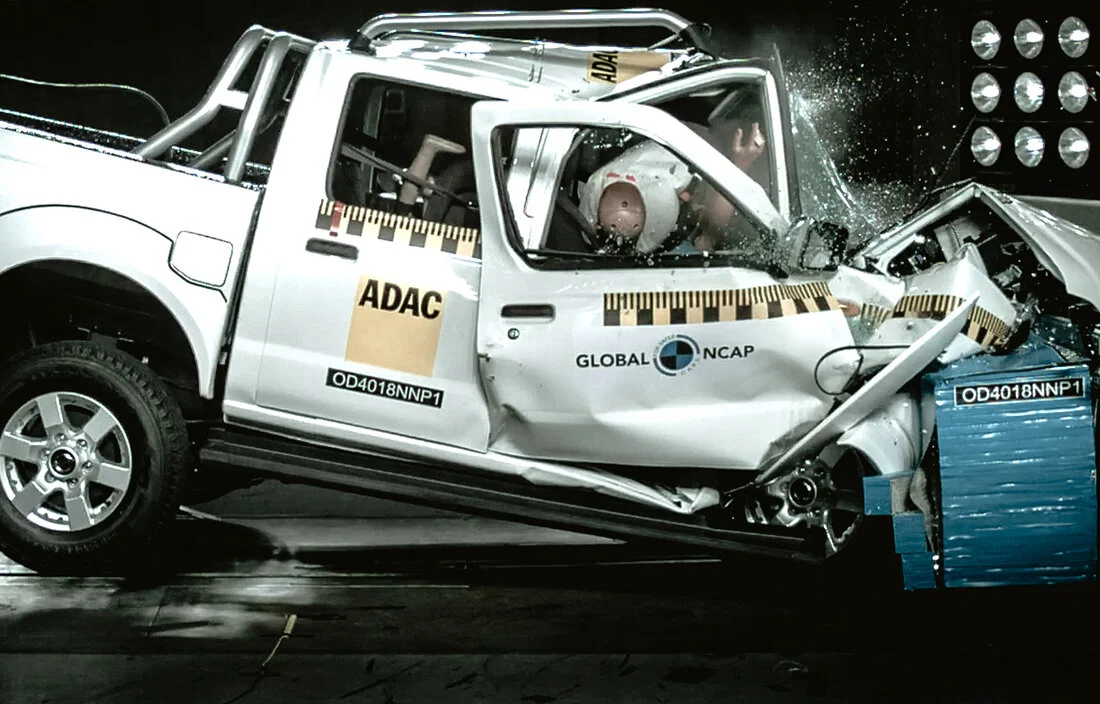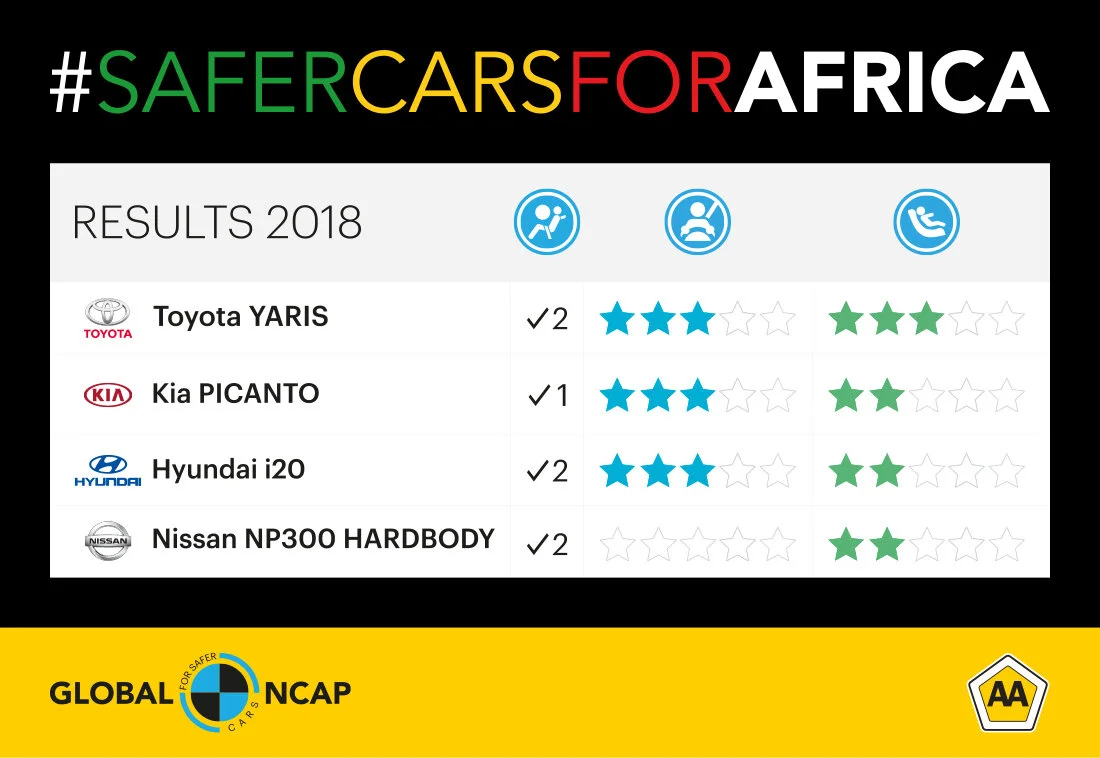Trio Of Three Stars But Shocking Zero For The Nissan ‘Hardbody’
Global NCAP and the Automobile Association (AA) South Africa launch the second round of #SaferCarsForAfrica crash test results today with the welcome support of the FIA Foundation and Bloomberg Philanthropies. The four models tested show a wide range of safety performance, from zero to three stars for adult protection, with the Nissan NP300 ‘Hardbody’ scoring the lowest ratings which result in a high probability of life threatening injury in a crash.
The models tested are: Nissan NP300 Hardbody, Hyundai i20, Kia Picanto and Toyota Yaris. Global NCAP chose the entry-level version of each model and as a result all were fitted with at least one airbag as standard. The results highlight significant differences in the structural integrity of the vehicles tested.
Collins Khumalo, CEO of the AA of South Africa said,
“Of concern with these results is that the most expensive vehicle tested in this round – the Nissan NP300 Hardbody – produced the lowest score of all tests completed to date, achieving a 00.00 score and zero stars. There should be no zero rated vehicles on our roads.
“What these results show is that three vehicles priced lower than the Nissan produced three-star ratings for adult occupancy indicating that safety does not have to be tied to price. They also emphasize that cars may not be what they seem based purely on looks and descriptions, and that until many more vehicles are tested, this issue may be a much bigger problem throughout Africa than we originally believed.”
David Ward, Secretary General of Global NCAP said,
“A trio of three star results are acceptable but the zero star Nissan NP300 is shockingly bad. It is astonishing that a global company like Nissan can produce a car today as poorly engineered as this. The NP300 ‘Hardbody’ is ridiculously misnamed as its body shell has collapsed. Nissan also claim the car benefits from a so called ‘safety shield’ but this is grossly misleading. Our test shows that the occupant compartment completely fails to absorb the energy of the crash resulting in a high risk of fatality or serious injury. “
Saul Billingsley, Executive Director of the FIA Foundation said,
“The #SaferCarsForAfrica campaign introduces essential transparency to the South African car market, and these results show that consumers are still getting a raw deal. The ironically-named ‘Hardbody’ is the worst of the bunch, but all these car makers should be doing better, and offering the same high standard of safety in South Africa, and across the African continent, as they do in Europe and the US.”
Kelly Larson, who directs the road safety program at Bloomberg Philanthropies, said:
“All car companies have the technology to make safe cars. The automobile industry must agree to meet the UN recommendations on vehicle safety standards across all market regions, including Africa, so all passengers can be protected in the event of a crash.”
Nissan NP300 ‘Hardbody’
The NP300 ‘Hardbody’ achieved an alarming zero star rating for its poor adult occupant protection mainly in the driver head and chest areas in the frontal crash test at 64km/h. The vehicle structure collapsed during the crash test and it was rated as unstable. The steering wheel column did not collapse penetrating the passengers’ compartment, creating an additional risk for the driver as it moved straight into the dummy chest. This performance showed a significant risk of injuries for the driver despite the car being equipped with double frontal airbags. The high probability of life threatening injuries to the driver’s head and chest resulted in the zero star adult occupant protection rating. Even with an airbag the driver’s head and chest showed high biomechanical readings. The NP300 ‘Hardbody’ achieved two stars for child occupant protection, the low result is mainly explained by the decision of the car manufacturer to install one of the Child seats without following Child seat manufacturer clear instructions.
Toyota Yaris
The Yaris achieved a three star rating for adult occupant protection in the frontal crash test at 64km/h. The vehicle structure was rated as unstable and offered marginal to good general adult occupant protection. The car provides seat belt reminders for both frontal positions. The car included seatbelts with pretensioners for both front passengers. Using the child seats recommended by Toyota, the Yaris achieved a three star rating for child occupant protection.
Hyundai i20
The i20 achieved a three star rating for adult occupant protection in the frontal crash test at 64km/h. The vehicle structure was rated as unstable as well as the footwell area. The protection levels ranged from marginal to good in adult occupant protection. The car offers seatbelt pretensioners for both front passengers and seatbelt reminder for the driver. Using the child seats recommended by Hyundai, the i20 achieved a two star rating for child occupant protection explained by the limited protection offered to the 3 year old dummy and lack of ISOFIX anchorages. The i20 structure is different to that of the European model. Safety equipment in South Africa does not offer Electronic Stability Control (ESC), side body airbags and side curtain airbags which are standard in Europe.
Kia Picanto
The Picanto achieved a three star rating for adult occupant protection in the frontal crash test at 64km/h. The vehicle structure was rated as stable while the footwell area was rated as unstable. The car offers seatbelt pretensioners for both front passengers and seat belt reminder for the driver only. Using the child seats recommended by Kia the Picanto achieved a two star rating for child protection. The detachment of the ISOFIX anchorages for the 3 years old CRS during the test explains the low score for child occupant protection. The manufacturer did not yet offer an explanation to this problem, but the child seat manufacturer which is also investigating, took immediate action and removed the Picanto from their recommended list of cars for this CRS model.
Global NCAP awards a separate child safety rating to each car in order to highlight the different levels of protection vehicles provide to passengers on the rear seats. Because the only safe way for young children to travel is properly restrained in a child seat, the assessment checks how compatible the car is with the child seats recommended by the manufacturer, as well as the protection provided in the crash test. Airbags are not a substitute for seatbelts, passengers must always wear seatbelts.
Only the Yaris and Picanto offered standard ISOFIX anchorages for child restraint systems (CRS). The NP300 Hardbody showed incompatibilities with the recommended CRS. Only the Yaris offered three-point seatbelt for all passengers facilitating the required conditions to safely install a child seat in all seating positions, while all the others offered a lap belt in the middle position which makes it impossible to properly install a CRS.
Nissan NP300 ‘Hardbody’
Read the full crash test report
Watch the crash test video
Download crash test image
Toyota Yaris
Read the full crash test report
Watch the crash test video
Download crash test image
Hyundai i20
Read the full crash test report
Watch the crash test video
Download crash test image
Kia Picanto
Read the full crash test report
Watch the crash test video
Download crash test image
About Global NCAP
Launched in 2011, Global NCAP serves as a platform for cooperation among NCAPs worldwide and to provide financial, technical and advocacy support to new programmes in emerging markets.
Global NCAP is a UK registered charity and its largest sources of funding come from the FIA Foundation and the Bloomberg Philanthropies. It works closely with the Towards Zero Foundation and leads the Stop the Crash Partnership.
Global NCAP has consultative status with the UN (ECOSOC), is a member of the UN Road safety Collaboration and an observer at the UN World Forum for Harmonisation of Vehicle Standards.
In 2016, Global NCAP received the Premier Prince Michael International Road Safety Award for outstanding achievement in vehicle safety.
For further information, to follow and share:
twitter.com/@globalncap
facebook.com/globalncap
instagram.com/globalncap
www.globalncap.org
About AA South Africa
The Automobile Association (AA) has been the trusted champion of the South African motorist and traveller for over 85 years. Along with our AA Accredited Sales Agent stores located countrywide, the AA offers access to over 50 benefits on 1 card as well as other travel and mobility services that extend far beyond 24-hour roadside assistance – from technical and legal advice, to emergency rescue services, roadside security and a mobile app suite. The AA offers specialised apprenticeships to help motor industry players build in-house skill, and short skill courses for individuals.
For further information, to follow and share:
twitter.com/aasouthafrica
facebook.com/aasouthafrica
www.aa.co.za
About the FIA Foundation
The FIA Foundation is an independent UK registered charity which supports an international programme of activities promoting road safety, the environment and sustainable mobility. Our aim is to ensure ‘Safe, Clean, Fair and Green’ mobility for all, playing a part to ensure a sustainable future through:
promoting research, disseminating the results of research and providing information in any matters of public interest which include road safety, automobile technology, the protection and preservation of human life and public health, transport and public mobility and the protection of the environment;
and promoting improvement in the safety of motor sport, and of drivers, passengers, pedestrians and other road users which works globally to promote safe, clean fair and green mobility.
For further information, to follow and share:
twitter.com/FIAFdn
www.fiafoundation.org
About Bloomberg Philanthropies
Bloomberg Philanthropies works in more than 120 countries around the world to ensure better, longer lives for the greatest number of people. The organization focuses on five key areas for creating lasting change: Arts, Education, Environment, Government Innovation and Public Health. Bloomberg Philanthropies encompasses all of Michael R. Bloomberg’s charitable activities, including his foundation and his personal giving. In 2016, Bloomberg Philanthropies distributed over half a billion dollars.
For further information, to follow and share:
twitter.com/BloombergDotOrg
facebook.com/BloombergDotOrg
instagram.com/BloombergDotOrg
www.bloomberg.org






